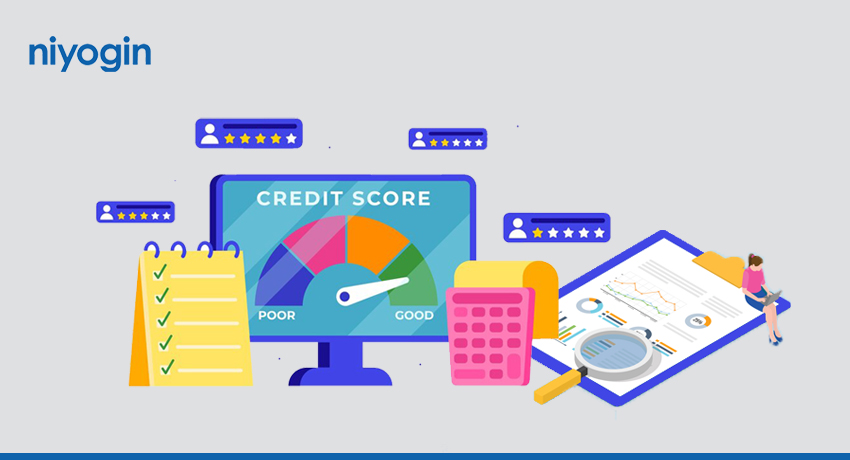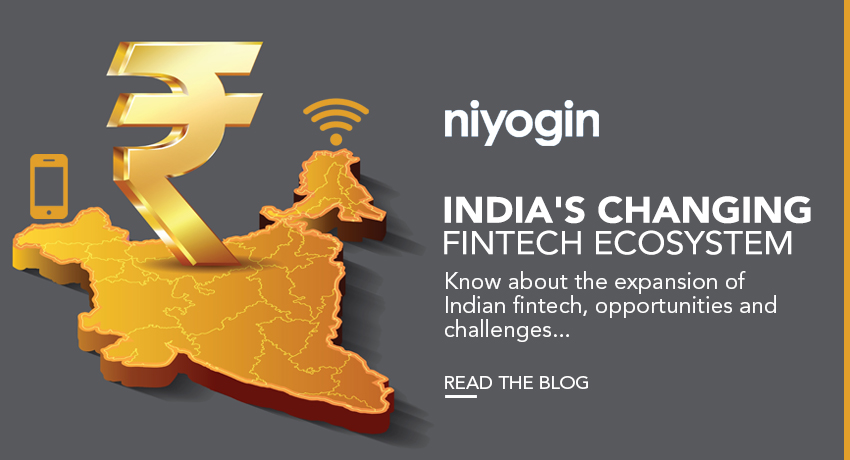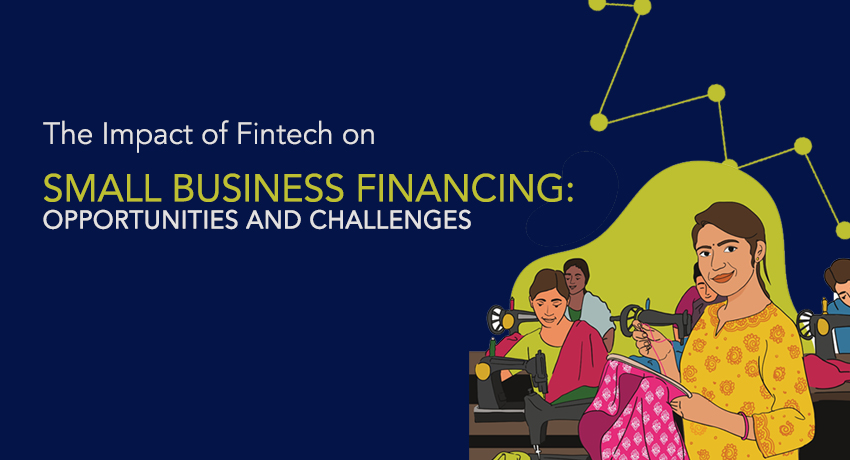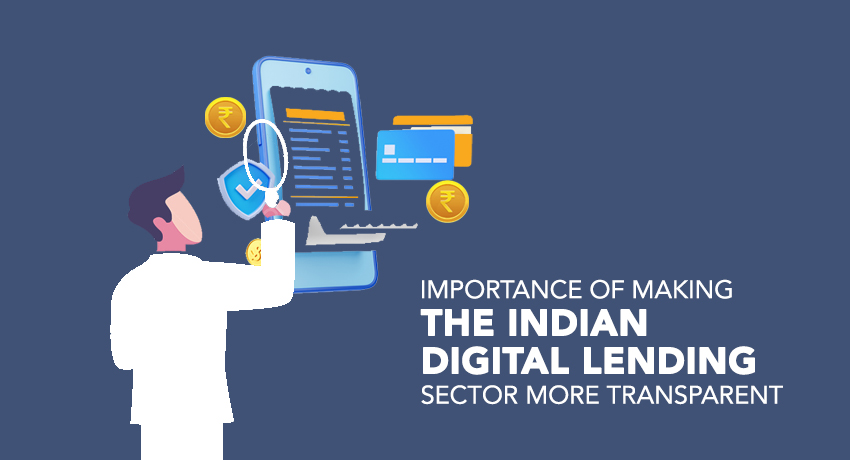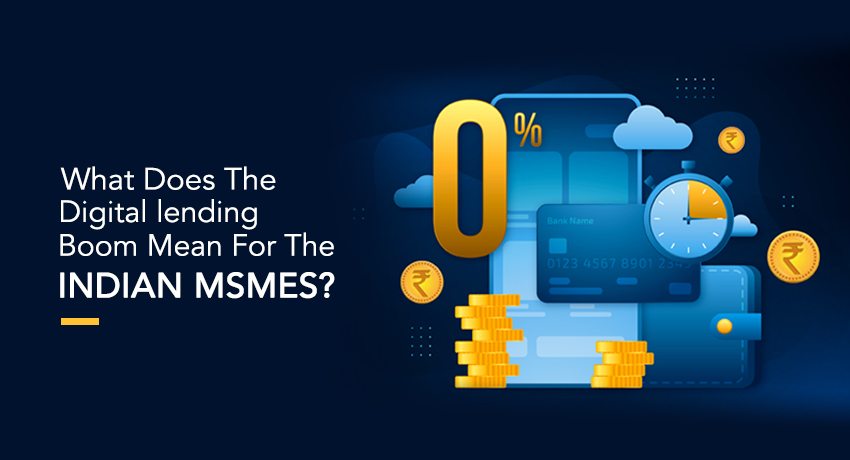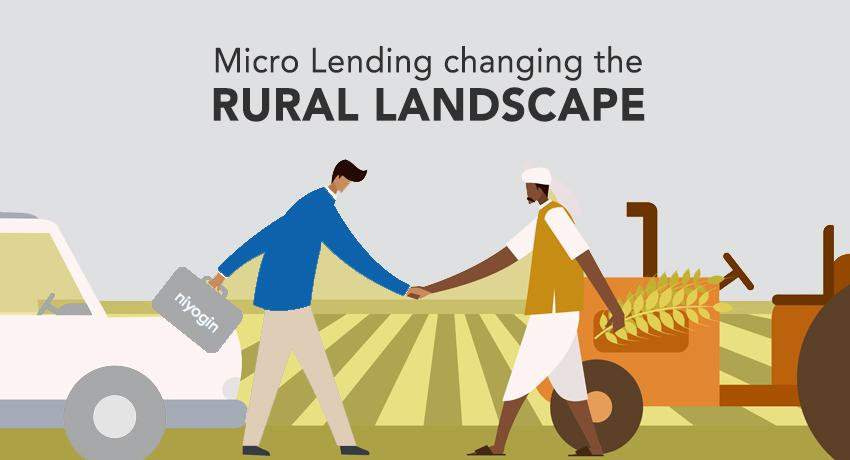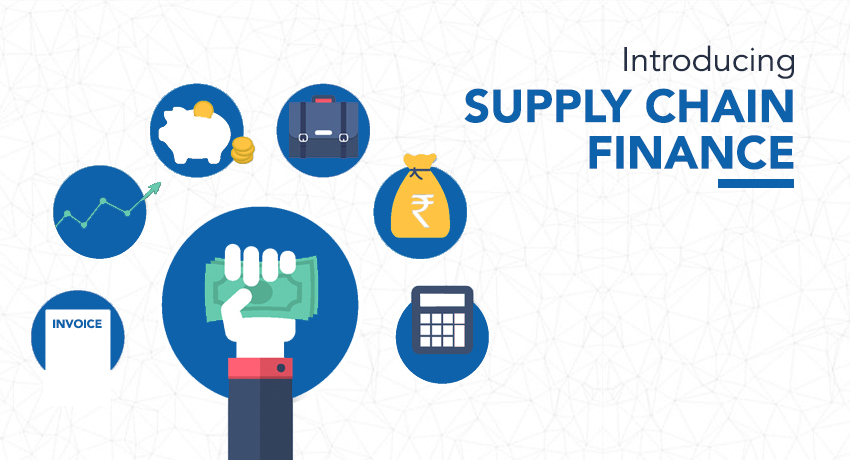Digital lending has fundamentally transformed the way financial institutions and borrowers engage in India. Fueled by the widespread adoption of smartphones, increased internet connectivity, and supportive government initiatives aimed at fostering digital financial inclusion, the digital lending sector has experienced remarkable growth. This shift has not only made access to credit more convenient and efficient but has also empowered underserved populations by bridging the gap between traditional banking services and emerging digital solutions. As a result, digital lending is reshaping the financial ecosystem, providing greater financial accessibility to millions of Indians. Current State of Digital Lending in India According to a report by Redseer Strategy Consultants, digital lending in India is projected to account for 5% of all retail loans by FY28, up from 1.8% in FY22. The key drivers of its growth include increasing smartphone penetration, government initiatives like Digital India and UPI, and rising demand for credit among the middle class and underserved segments. A diverse range of players, including banks, NBFCs, and fintech companies, are actively participating in the digital lending space. Emerging Technologies and Innovations Challenges, opportunities and the way forward Despite challenges, digital lending has a bright future in India. By embracing emerging technologies and addressing regulatory concerns, the industry can explore its full potential, driving financial inclusion and significantly contributing to the country’s economic growth. These challenges include ensuring data privacy and security, the establishment of a clear and supportive regulatory framework to foster innovation while protecting consumer interests, and improving financial literacy among borrowers to help them make informed borrowing and repayment decisions. The future of digital lending in India holds immense promise, fueled by these emerging technologies. These innovations are revolutionizing the lending ecosystem, enhancing efficiency, security, and customer experience. By overcoming existing challenges and capitalizing on new opportunities, India is poised to become a global leader in digital lending. This transformation will not only drive financial inclusion but also empower millions of citizens, creating a more accessible and equitable financial landscape for all.
Tag: lending
Credit Scoring and Risk Assessment in Digital Lending
Technology’s increasing pervasiveness and the growing call for financial inclusion are driving a rapid transformation of the Indian lending sector. The crucial roles of credit scoring and risk assessment are at the center of this evolution. After relying primarily on credit bureau data for a long time, the industry is now adopting a new paradigm that includes advanced analytics and alternative data sources in order to better assess borrowers. This shift is driven by several factors, including: From Traditional to Transformative A pivotal shift is underway, marked by the increased adoption of alternative data sources such as mobile phone usage, social media activity, and utility bill payments. These data, combined with the power of advanced analytics and machine learning, are enabling the development of more sophisticated credit scoring models that can accurately assess the creditworthiness of a broader population, including those with limited credit history. Regulatory initiatives like the RBI’s regulatory sandbox are fostering innovation by providing a controlled environment for lenders to experiment with new technologies and data sources. Moreover, the rise of open banking is facilitating the seamless sharing of customer data between banks and fintech companies, enriching the data pool available for credit assessment and ultimately enhancing the overall lending ecosystem. These trends are expected to make credit scoring and risk assessment in India more accurate, efficient, and inclusive. This will not only benefit lenders by reducing their risk of bad loans but also benefit borrowers by making it easier for them to access credit. As the industry continues to evolve, it is imperative to strike a balance between innovation and responsible lending. Robust data privacy and security measures, coupled with ethical considerations, will be paramount in building a sustainable and trustworthy credit ecosystem. The future of lending lies in the intelligent and responsible utilization of data to empower both borrowers and lenders.
India’s Changing Fintech Ecosystem
In recent years, India’s fintech ecosystem has undergone a spectacular transition, revolutionizing how financial services are accessed and delivered. The convergence of technology, shifting customer tastes, and supportive legislative actions have resulted in a dynamic and diverse fintech ecosystem. From payments and loans to wealth management and insurance, the industry’s rapid expansion has not only boosted financial inclusion but also paved the way for creative solutions catering to a wide range of customers. The emergence of fintech in India can be attributed to a number of elements coming together. One of the key motivators has been the phenomenal growth of smartphones and internet connectivity, particularly in rural areas. This digital flow has produced a massive client base with access to digital financial services. Digital payments and Remittances With the launch of the Unified Payments Interface (UPI), India’s digital payments market has undergone a seismic upheaval. UPI has streamlined peer-to-peer transactions, allowing for quick and smooth money transfers. This innovation has not only reduced reliance on cash but has also accelerated the adoption of digital wallets and mobile banking apps. Furthermore, the government’s demonetization campaign in 2016 served as a spark, encouraging more individuals and companies to accept digital payments. Online Lending India’s ancient banking system frequently denied formal credit to a large segment of the population. Fintech platforms filled this void with novel loan strategies. These platforms analyze creditworthiness and distribute loans quickly by leveraging alternative data sources and smart analytics, making lending available to both individuals and small businesses. Investment and Wealth Management Fintech has democratized wealth management by giving consumers platforms to invest in stocks, mutual funds, and other financial instruments. Robo-advisors have gained popularity by providing algorithm-driven investing recommendations suited to individual risk profiles. This trend has made it easier and less expensive for regular investors to participate in the capital markets. Insurtech The insurance industry has also been transformed by fintech. Insurtech businesses use data analytics, artificial intelligence, and IoT devices to customize insurance policies, speed claim processing, and improve customer experience. This has made insurance products more accessible, inexpensive, and responsive to customer needs. Challenges and Opportunities Despite its rapid growth, the Indian fintech ecosystem faces certain challenges. Data security and privacy concerns, regulatory uncertainties, and the need for constant innovation are some of the hurdles that industry players must navigate. Additionally, ensuring financial literacy and digital literacy among the masses remains critical to harnessing the full potential of fintech. However, the possibilities are numerous. The government’s “Digital India” program and initiatives such as the “Jan Dhan Yojana” have paved the way for a financially egalitarian digital environment. Collaborations between established financial institutions and fintech firms can help deliver more comprehensive and efficient services by using each other’s capabilities. Regulatory Outlook India’s regulatory organizations have taken an aggressive stance towards fintech. The Reserve Bank of India (RBI) has implemented policies to encourage innovation while maintaining financial stability. The regulatory framework allows financial firms to test their ideas in a controlled environment, stimulating innovation while limiting risks. Furthermore, the RBI’s rules on digital KYC and data localization indicate the authorities’ commitment to balancing innovation and security. India’s fintech sector has grown from a niche market to a significant force altering the country’s financial environment. The convergence of technology, creativity, and regulatory support has enabled fintech to overcome gaps, increase financial inclusion, and improve the efficiency of financial services. As the ecosystem matures, collaboration, innovation, and regulatory vigilance will be the cornerstones of its continuous growth, ultimately leading to a more inclusive and digitized financial future for India.
Alternative Finance Instruments: How Do They Help SMEs Grow?
Alternate financing describes a category of financing products that includes venture capital, invoice finance, cash flow loans, and debts. In India, such solutions are now primarily favoured by SMEs and startups. This pattern is a component of the broader drive towards financial inclusion, which aims to increase access to formal banking institutions for more individuals. According to the World Bank, financial inclusion is ensuring that companies have access to practical, reasonably priced financial solutions that satisfy their needs in an ethical and sustainable manner.India accounts for around 81.3% of the South Asian market. By 2030, digital lending in India is estimated to reach $1.3 trillion. Artificial intelligence is used by digital lenders to analyze creditworthiness, allowing these fintech firms to reach underserved populations. National digitization activities also contribute to the expansion of alternative financing. The Rise of Alternative Financing Start-ups and SMEs must adapt to the increased requirement for remote working as a result of the pandemic. Due to the requirement for scaling, SMEs sought alternative funding sources. With the advancement of technology and the advent of artificial intelligence, organizations continually require financial resources to compete in today’s market. This growth in innovation has always resulted in a diversity of finance strategies to assist SMEs. Alternative financing solutions for small enterprises include peer-to-peer lending, cash flow, crowdsourcing, and invoice financing. Alternative Financing Drives SME Growth SMEs that have been denied funding from traditional loan providers such as banks and financial markets look to alternative financing sources to obtain the capital they want. In developing nations such as India, it is estimated that over 83% of SMEs lack appropriate finance. The growth of the fintech industry has prompted SMEs to invest in fintech services and seek other forms of financing. The emergence of fintech and alternative finance models has resulted in a faster loan approval procedure, the acceptance of smaller loans, and a reduction in the cost of capital and transactions for SMEs. Fintech has played a significant role in increasing the number of investors due to its diverse financing structures and growing array of investment methods. Peer-to-peer lending has gained popularity, aided by fintech websites. Interested investors can use P2P platforms to connect with borrowers looking for loans, eliminating the need for a financial institution. Competition from the peer-to-peer sector will also motivate banks to use fintech services to provide financial support to SMEs. As of March 2022, the lending market in India rose by 11.1% This expansion is due to the lending sector’s shift towards alternative finance, which is aided by data-driven lending. As a result, SMEs and small firms are no longer restricted to the traditional bank loaning structure due to the availability of alternative financing options. In this modern age of growing fintech services and AI models, the funding system has been positively impacted as it has attracted a large number of new investors who would not have been players in the market if not for the variety of different investments and return on investment options.
Can Co-Lending Models Be The Future Lending in India?
Co-Lending Models (CLM) is a revolutionary method of lending that has the potential to change the financial sector’s landscape in India. CLM entails cooperation between established financial institutions, including banks, and online lending platforms, utilizing each other’s advantages to offer more open and inclusive credit options. According to research by EY, the fintech industry in India will generate $200 billion in revenue by 2030. Fintech is at its pinnacle now more than ever due to the nation’s increasing need and demand for digital and financial inclusion. CLM: What problems does it solve? The Co-lending model was initiated with the means to ease the lives of people living in that sector of the economy that is not familiar with or used to the idea of banking operations. With the implementation of CLMs, let’s understand the problems it solves: Reaching credit-deprived communities: Out of 68% of India’s population living in rural areas, 28% are without financial literacy and internet-enabled smartphones. These people can, however, through CLMs get access to lending products without having to go through any hassle. Further, there are many people with no credit history. Co-lending models can help overcome this problem by using alternative data sources and sharing risk between lenders, making it easier for unbanked individuals to obtain loans. Dissemination of knowledge: One of the main reasons that are responsible for a huge amount of underserved population is lack of knowledge. In addition to providing loans, NBFCs, and fintech go the extra mile to ensure their customers understand the terms and conditions of the contract before they sign, thus contributing to financial literacy. Cost cutting: In order to make the lending process more efficient, with CLMs, consumers don’t have to pay high-interest rates. Co-lending models can help reduce interest rates by allowing multiple lenders to share the risk and distribute the interest charges across multiple parties. Future of Lending in India: Is it CLM? As per research by Forbes, co-lending allows these two pillars of the economy – NBFCs and banks, to unite and act as one to provide the best to the whole economy. Statistically speaking, by FY23, the co-lending model is expected to generate approximately Rs. 300 billion. Indian co-lending arrangements will likely undergo several innovations, with digital financial literacy, as well as credit penetration, being two of the government’s top priorities. Overall, co-lending models have the potential to address many of the challenges facing the lending industry in India and could become an important part of the future of lending in India. Conclusion Co-Lending Models stand out as a promising solution to satisfy the various credit demands of people and enterprises across the nation as the Indian financial ecosystem develops further. This cooperative strategy promotes economic growth while simultaneously capturing the shifting dynamics of a digitally empowered economy.
The Impact of Fintech on Small Business Financing: Opportunities and Challenges
Fintech has disrupted the traditional lending landscape, making it easier for small businesses to access funding and increasing competition among lenders. According to Business World, statistics show that SMEs have contributed to the employment of over 9.4 million people and account for 30% of the nation’s GDP. Small businesses have grown significantly, but it has come at a price. Many SMEs currently face significant difficulties as a result of financial issues or perhaps a lack of resources. SMEs must improve if they hope to beat the 10% growth rate of prior years. Following are some of the ways in which Fintech has had a significant impact on Small business financing: Increased access to capital Fintech has increased the funding choices available to small businesses compared to the past and made it simpler for them to obtain capital. By lowering the friction in the financing process, fintech enables small businesses to apply for and get loans more quickly. Flexibility to withstand adversities Fintech lenders frequently provide loan terms that are more flexible than those offered by traditional banks, such as shorter loan terms, lower minimum loan amounts, competitive interest rates, and individualized payback plans. Small firms that require specialized financing may benefit from this since they may not meet the major banks’ standard lending requirements. Elimination of extra overhead expenses One of the critical benefits of fintech is that it reduces unnecessary administrative expenses and aids small firms in cost-cutting. Opportunities in SME lending : Personalized Financing Solutions Fintech lenders frequently utilize data analytics and algorithms to determine credit worthiness, which enables them to offer small firms more specialized funding options. This may lead to loans that more closely match the company’s demands and its particular financial circumstances. Governmental Initiatives Along with providing automatic foreign direct investment, the government has launched a number of other programmes and initiatives. These programmes include, among others, Stand-up India, the Growth Capital and Equity Assistance Scheme, and MSME Business Loans in 59 Minutes. Challenges in SME lending : Insufficient knowledge There are still certain gaps in people’s understanding or awareness of SME loans in the fast-paced world of today. Many people still trust traditional banks despite the rising demand, but this obstacle is considered a chance for growth, and as facilities increase, everyone will undoubtedly adjust to these advancements. Conclusion Fintech is positioned to transform every industry, from promoting digital lending to encouraging a cashless society. However, before making a choice, small businesses must carefully weigh the advantages and drawbacks of partnering with a fintech lender. Despite the challenges associated with Fintech adoption, its advantages and innovation should not be disregarded. In the upcoming years, it will continue to influence the lending environment for SMEs.
The Potential of Co-Lending for the Underserved Segments
Millions of people in India and around the world do not have access to traditional lending services, although credit access is essential for financial inclusion and economic progress. According to a recent TransUnion analysis, there are over 160 million credit-invisible individuals in India who are unable to obtain loans from banks and other formal financial institutions because they need the appropriate credit histories. The emergence of co-lending has the potential to address this gap and provide access to credit for unserved and underserved segments. Co-lending enables NBFIs to underwrite loans alongside banks, sharing the risks and benefits of the lending process. As a result, borrowers who may not have been able to access credit from banks can receive loans from a combined pool of capital, reducing their dependence on informal lenders and avoiding high-interest rates. The Emergence of Co-Lending as a Solution To maximize co-lending potential, traditional lenders and NBFIs must collaborate and form partnerships that leverage their respective strengths. Banks bring expertise in underwriting and credit risk management, while NBFIs can bring their knowledge of underserved segments and their needs. NBFIs can leverage their expertise and experience to identify potential borrowers who may not meet the eligibility criteria of traditional banks or may not have access to formal financial services. By working together, traditional lenders and NBFIs can reach more customers, provide more financing options, and drive financial inclusion and economic growth. Potential Impact of Co-Lending Risks and Challenges Co-lending can bridge the financing gap for micro, small, and medium-sized enterprises (MSMEs). It involves sharing credit risk between different types of lenders and has its own set of risks and challenges, including: Coordination Risk Co-lending requires coordination between different lenders, which can be challenging and time-consuming. Differences in lending policies, procedures, and practices can also make coordination more difficult. Compliance Risk Co-lending requires compliance with various regulations and guidelines, which can be complex and challenging. Different lenders may have different compliance requirements, making it difficult to ensure that all parties are meeting their regulatory obligations. Operational Risk Co-lending can involve operational challenges, including issues with loan documentation, servicing, and monitoring. Failure to manage these operational risks can lead to loan defaults and financial losses. Legal Risk Co-lending can involve legal risks, including issues with loan documentation, loan servicing, and loan monitoring, resulting in legal disputes between the lenders. In spite of the challenges, co-lending has become a potentially effective way to meet the financial needs of neglected and unserved markets. It helps close the funding gap for these segments, lessen their reliance on informal lenders, and promote economic growth by allowing traditional lenders and NBFIs to work together and utilize their capabilities.
Growth Of Retail Lending and Its Impact on Underserved Segments
Retail lending has grown significantly over time as a result of technological improvements, changing consumer behaviour, and increasing regulatory frameworks. While this expansion has given customers many choices, it has also significantly impacted small enterprises. In a collaborative analysis from CRISIL and ICICI Bank, it is predicted that retail lending will increase by $96 trillion by 2024. The banking industry had to step up its game in light of the COVID-19 pandemic and the surge of digital innovations. Retail lending has advanced significantly, from mobile applications to electronic payments. Retail lending solutions have been acknowledged as a cornerstone for a bank to build a long-term relationship with its consumers. Lenders have the opportunity to interact with borrowers and create enduring bonds when they engage in loan transactions. The growth in the retail lending sector has been driven by several factors, including low-interest rates, increased access to credit, and a growing population of consumers. In recent years, online and digital platforms have also made it easier for consumers to apply for and receive loans, further fueling growth in the retail lending market. Additionally, the rise of fintech companies has contributed to the growth of retail lending as they offer alternative lending options to traditional banks. Retail loans formed about one-third of the total banking system’s gross advances. It is important to know that the composition of secured and unsecured advances has changed between 2021-2023, with unsecured retail loans increasing from 22.9 percent to 25.2 percent. However, one can question if retail lending is gaining traction for small firms. 80% of all industrial organizations are small firms. Following is a list of the growing retail lending market’s impacts on underserved segments. Increased consumer spending Consumers may have more disposable income to give to small businesses as a result of taking out additional loans. Consequently, this will enhance small firms’ income and sales. Improved access to credit Small businesses may find it simpler to obtain the funding they need to grow and expand thanks to an increasing variety of retail lending choices. For instance, up until 2019–20, retail credit increased by 16.6% year over year (YoY). Forecasts indicate that retail lending will expand more slowly than it did prior to the epidemic. Increased competition The expansion of retail lending may also lead to increased competition among lenders, which could lead to lower interest rates and better loan terms for small firms. Fintech companies Due to the growth of retail lending, fintech businesses can provide alternatives to traditional banks. They can provide easier-to-approve funding solutions that are more accessible, particularly for small enterprises. Boost to the economy Retail lending can help create jobs and boost economic activity, in addition to promoting economic growth, by giving consumers and small businesses the money they require to purchase products and services. For instance, the number of loans granted for agricultural and allied operations jumped from 2.4% in June 2020 to 11.4% in June 2021. Digitization Small companies gain from adopting a digital-first strategy by taking advantage of the automation of retail financing and the transition from a more traditional approach to one that is more digitized. With the use of fintech, the retail loan process can be digitized, and by digitizing the customer journey, operational efficiency can be raised by 20 to 30%. Conclusion The effects of expanding retail lending on small firms could, however, alter depending on how the market is doing at any given time. One may need to be educated about these changes in order to make judgments as a small business owner. Small businesses have been greatly influenced by the expansion of the retail lending environment, whether due to automation or greater demand.
Importance of making the Indian Digital Lending Sector more Transparent
Transparency is a fundamental cornerstone of trust in any lending relationship, and it has special significance in the context of small business lending. The expansion of the economy, the creation of new jobs, and innovation are all significantly influenced by small enterprises. Small firms frequently encounter difficulties obtaining capital due to the complexity of the lending environment. Transparency becomes essential in this situation to guarantee honest, moral, and ethical lending practices that benefit both lenders and small enterprises. Only 48% of small firms can currently pay their financial obligations. The need for transparency in the financing process is greater than ever. Additionally, financial institutions must be more fair and open given the destruction the COVID-19 outbreak has caused. Financial resources are constrained, so investments must be better targeted if they are to yield the maximum results. Maintaining financial transparency is crucial for small and medium-sized businesses (SMEs), which are frequently unable to offer bank collateral in order to attract such investment. Good prospects and companies with sound financial reporting procedures will have a greater chance of obtaining credit without having to put up a lot of collateral since banks will have more information on which to base their lending choices. Small Business Lending: The Value of Transparency According to a World Bank assessment, there are $5.2 trillion in unmet financing needs for micro, small, and medium-sized businesses worldwide, which is nearly 1.5 times their present loan market. The idea of transparency in small company lending refers to bank lending where information is published to make sure the borrowers are fully aware of the terms and circumstances of the credit. According to estimates, only 14% of small businesses that applied for loans received all of the funding they wanted. Transparency is therefore more important than ever. It is possible to achieve greater transparency by disclosing important information to the borrower before signing an agreement about loan prices and fees. Additionally, bank transparency requires them to refrain from irresponsible lending by keeping hidden fees and unexpected rate increases hidden from borrowers, which are not disclosed upfront. At the beginning of the agreement, the borrower should be informed of all charges and the possibility of increases. Credibility When small company lending is transparent, a lender-borrower relationship is based on trust. Borrowers might have doubts about the loan, interest rate, or repayment plan if these details are not made transparent. If there is a lack of openness, the borrower can also find it challenging to understand how the lender uses their financial and personal information. Successful Credit Grant Growing firms looking to borrow money from the bank may have a lot of sway if they can consistently and successfully create accurate financial reports. Furthermore, since they give banks the crucial data they need to make loan choices, high-quality, honest financial reports eliminate the requirement for significant collateral. Information Shortage Small business owners are reportedly paying up to 50% in interest without much knowledge, according to a study by the Opportunity Fund and the Federal Reserve. Little companies lose money as a result of this. Small businesses struggle to make informed judgements and evaluate pricing due to a lack of information, such as loan rates. In conclusion, transparency in small business lending is essential for fostering trust, promoting fairness, complying with regulations, and supporting the financial success of both lenders and borrowers. Transparent lending practices create a level playing field, enabling small businesses to thrive and grow sustainably.
What Does the Digital Lending Boom Mean for Indian MSMEs?
The Micro, Small, and Medium-Sized Enterprises (MSMEs) in India will be significantly impacted by the surge in digital lending. MSMEs are essential to the Indian economy and make a substantial contribution to job creation and general economic expansion. Over the past few years, MSMEs’ use of Internet payments has increased by 50–100%. According to a Global Findex Report, In India, only 8% of people borrowed money through official sources. Over the past five years, the Reserve Bank of India (RBI) has made great progress since creating a robust framework to oversee digital lending. India’s Fintechs have been able to thrive due to the solid payment structure governed by the government, which has led to an increase in bank account openings—more than 50% of which are attributable to Fintech. Growth of Digital Lending and its Effect on Indian MSMEs: The MSME sector has improved as a result of the RBI’s support for sandboxes to foster innovation in the MSME sector and NITI Aayog’s promotion of digital banking for Indian companies. Statistics show that one of India’s fastest-growing Fintech industries is digital lending. By 2030, the book size of Indian digital lending firms is anticipated to climb from USD 38.2 billion in 2021 to roughly USD 515 billion, with a 33.5% increase in CAGR. Some effects that digital lending has had on Indian MSMEs include the following: Several digital lending software, including Lending Kart, Cash Suvidha, Namaste Credit, and Flexiloans, have found new markets because of digital lending. The post-pandemic atmosphere has also permitted MSMEs to include online lending platforms in their systems to achieve credit standards. The firms were in desperate need of loans made available by the accessibility of digital financing when the demand for MSMEs in India decreased in the years 2020–21. The Indian MSMEs could then build up their resources and utilize the technology. Local and in-person lenders typically only provide loans to MSMEs with the requirement of collateral, which is a cause of concern for MSMEs, particularly those with lower turnovers. To solve this issue and provide loans without collateral, contemporary start-ups have impacted cutting-edge technology like machine learning and artificial intelligence. Without having to contact banks for loans frequently, loan offers can be sent via digital lending software from anywhere in the world to a large number of vendors. The loan process in the digital age significantly improves the effectiveness of MSMEs’ support systems. According to a number of study surveys, 60–80% of Indian MSMEs now sell their products and accept payments online. All Indian MSMEs now need to use technology, whether it be for bookkeeping, digital transactions, or accounting, and the pandemic has accelerated this demand. According to the annual report of the Ministry of MSME for 2020–21, India is home to about 6.33 crore MSMEs, all of which make significant contributions to the GDP, employment, and economy of the nation. It is therefore plausible to predict that MSMEs will, over time, adopt secured technological software to facilitate financial transactions, which will ultimately spur efficiency and advancement in general.
Fintechs designing the ‘One Platform’ Concept
With thousands of Fintechs in the market constantly experimenting with newer products and services, the idea of bringing it all to a single platform was quite anticipated. However, Fintechs are now expected to do much more. Fintechs began by designing a virtual universe where customers could choose from a range of products and services; however today, they are allowing customers to avail of all the services on a single platform. For instance, providing insurance with credit, payment gateways on investment platforms, credit on shopping apps, etc. Although Fintechs face an array of challenges pertaining to their strategic directions, they emerge with better services across financial needs. The purpose of designing the ‘One Platform’ concept Fintechs are creating single platforms for multiple services for several reasons: Convenience – Having multiple services available in one platform makes it more convenient for customers to manage their financial needs without having to switch between different applications or websites. Cost Savings – Developing and maintaining multiple platforms for different financial services can be costly for fintech companies. By offering multiple services on a single platform, they can save on development and maintenance costs. Cross-selling – Fintechs can use the multiple services offered on a single platform to cross-sell their other services to existing customers, thereby increasing their revenue streams. Data Analytics – Fintechs can leverage the data generated by the various services on their platform to gain insights into their customers’ financial behaviour, which can inform future product development and marketing efforts. Competitive Advantage – Fintechs that offer multiple services on a single platform may have a competitive advantage over traditional financial institutions that offer separate platforms for different services. This can help fintechs attract and retain customers who prefer a more streamlined and integrated financial experience. The benefits of having multiple solutions on a single platform There are several benefits that users can enjoy when multiple financial products are available on a single platform – How are Fintechs designing the ‘One Platform’ concept? Fintechs are creating single platforms for multiple services by leveraging technology and partnerships with other companies. Here are some ways in which fintechs are creating these platforms: API Integration – Fintechs can integrate different financial services, such as banking, lending, investment, and insurance, using Application Programming Interfaces (APIs). APIs enable different software systems to communicate and exchange data with each other, allowing fintechs to combine services from multiple providers into a single platform. Partnerships – Fintechs can partner with other companies that offer complementary financial services to expand their offerings on a single platform. For example, a fintech company that provides investment services can partner with a bank to offer banking services to its customers, all through a single platform. In-house Development – Fintechs can also develop their own in-house financial services and integrate them into a single platform. This can include building their own payment processing systems, digital wallets, or investment platforms. Acquisitions – Fintechs can acquire other companies that provide different financial services and integrate them into their existing platform. This can help fintechs quickly expand their offerings and gain access to new customer bases. Overall, fintechs are using a combination of strategies to create single platforms for multiple financial services, enabling customers to easily manage their financial needs from a single point of location. They are ensuring that their focal point is the users, their journey, experience and benefits.
Micro-lending changing the Rural landscape
The origination of the micro-lending industry in India dates back to the 1980s when India took inspiration from Bangladesh’s successful reforms where they benefitted from distributing loans to the underprivileged women of their region. What began as an experiment, quickly turned into something substantial for India. Today, India’s micro-lending portfolio stands at Rs 2.93 Lakh crore with 6 crore unique borrowers and shows a further growth of 23.5% yearly. With a loan portfolio worth Rs 2.93 lakh crore, the microfinance industry grew by over 16 times in the last 10 years. Majorly served by 202 businesses, roughly over 130 million Indian households, i.e., one-third of the population have access to microfinance as per NABARD’s Status of Microfinance in India report for 2020-2021. Over the years, the success of micro-financing has witnessed a visible shift from banks to NBFCs. According to Sa-Dhan – an association of the Micro-Finance Institutions (MFIs), the NBFC sector is currently dominating with a usage share of 37.53% while banks take a 36.18% slice of the pie, giving away the remainder to other institutions. The total portfolio size of NBFC- MFIs has grown nearly by 7% quarter-on-quarter and amounted to Rs 1,01,678 crore as on September 2022. Inquiring deeper, as per Microfinance Institutions Network, NBFC-MFIs have 22% of their portfolio in urban India and 78% in rural. What has been the micro-lending threat in Rural India Small business owners and merchants, especially ones residing in rural India were often left underserved by the mainstream financial institutions given the high-risk quotient they bring with them. High operational costs coupled with the threat of fraud, defaults and NPAs often left banks in a grey area on how to service the said market. Moreover, Regional Rural Banks (RRBs) that service the rural market often face trouble with inadequate finance since they depend on NABARD to collect finance for their further operation. Given that rural households often have low capital income and hence, collecting deposits to raise funds has been the root cause of this entire fiasco. Rural households largely depend on natural resources like agriculture and other rural economic activities for their survival therefore, natural calamities and other natural menaces play a big role in the success of their business cycle. However, reimagining a way with lower operating and market costs by financial institutions has ensured an improved lifestyle for many rural households. It has further led to the growth of the said sector. Micro-lending changing the landscape Micro-loans are distributed by a range of institutional channels– Scheduled commercial banks (including small finance banks and regional rural banks) Cooperative banks Non-banking financial companies Microfinance institutions However, NBFCs hold a major chunk of this market followed by banks and other micro-finance institutions. A combined amount of Rs 45,830 crore in the form of micro-loans was disbursed in the quarter ending December 2022. Micro-lending institutions are expanding their services by introducing other financial services like insurance, remittance, AePS, etc. while providing training and assistance to the unversed. As for the market leaders; NBFCs have introduced a new technology that enables borrowers to make daily repayments against their loans called Equated Daily Instalments. They have also introduced PoS devices, apps, etc. to allow small businesses to benefit from digital payment methods. Despite a myriad of services already designed for small businesses, financial institutions still have a great scope of work in the said segment. With the MSME sector offering 111 million job opportunities and contributing to close to 30% of the nation’s GDP, there’s still a credit gap of $397 billion; a sizeable opportunity for financial institutions. With the RBI’s new guideline published on March 14, 2022, where they have notched up their support, micro-loans have been defined as collateral-free loans to a household comprising husband, wife and unmarried children and with a yearly income of up to Rs 3 lakh (revised from Rs 2 lakh for urban areas and Rs 1.6 lakh for rural areas earlier). The new rules also lift the price cap on interest rates to ensure that all microlenders are brought on common ground. Where rural households with small businesses struggled to avail basic amenities are today given access to a range of financial services allowing them to attain financial freedom. Micro-lending is changing the rural landscape by offering households the finance they require to build themselves. Although the service is still in its embryonic stage with a wide gap to fill, it can widen its audience range and promote inclusivity in the long run.
Introducing Supply Chain Finance
Supply Chain Finance (SCF) is a technology solution that lowers financing costs for buyers and sellers. It tracks invoice approval and settlement and automates transactions to improve the efficiency of all the parties involved in a sales transaction. The supply chain financing market is expected to reach a CAGR of 17.1% by 2024. According to Mckinsey reports, SCF eligibility will increase from less than 40% to as much as 80% in the upcoming years as supply chain leaders are looking for better solutions. By 2031, the supply chain finance market is expected to reach $13.4 billion. Indian Supply Chain Financing Ecosystem Challenges Compared to global trends, India’s supply chain financing (SCF) is still nascent. Indian MSMEs employ more than 11 crore people and contribute 29% of the GDP. Also, 70% of MSMEs require working capital funds. However, SCF remains inaccessible due to the legacy banking systems. Many MSMEs don’t meet the banking requirements criteria. The estimated credit gap is Rs. 20-25 trillion. This credit gap forces the MSMEs to approach third-party lenders, which results in higher costs, stunted growth, low profitability, and a volatile business model. The COVID economic disruption doesn’t help either. The low-cost SCF option provides extended financing for MSMEs and helps lenders manage credit risks. Source: Allied Market Research According to the new Factoring Regulations Act 2011, more than 182 NBFCs can now offer factoring services. Previously, NBFCs could meet only 20% of the funding requirements for MSMEs. Digitisation Is Paramount To SCF Innovation Digitisation is the key to achieving seamless SCF solutions for Indian MSMEs. Businesses will have access to more customised SCF products that help increase the working capital. Apart from invoices, businesses can benefit from other fintech offerings such as a letter of credit, import and import bills, shipping guarantees, performance bonds, and more. Technology innovations such as fintech digital delivery, industry utilities, API technologies, and blockchain bring supply chain financing closer to SMEs. With the non-availability of credit history, lenders can use AI-based risk assessment solutions to evaluate creditworthiness. Such solutions also predict business growth, enabling lenders to offer SCF financing. Source: PWC Fintechs can bring about innovation in SCF solutions in the following ways: Incorporate API-enabled services using a customer-centric tech stack. Use data to understand supply chain networks to innovate new opportunities. Use blockchain-distributed ledgers to improve the transparency of the financing platform. Introduce innovative products such as CAPEX discounting, invoice discounting, warehouse receipt finance, dynamic discounting, early cycle discounting, and SCF securitisation. Various initiatives from the Government of India encourage SCF. The fintech platforms can use the existing rails to improve their SCF offerings in the following ways: Leverage TReDS and GSTN linking to understand MSME cash flows for invoice financing better. Use the AA framework to provide financing options for suppliers and buyers. India’s addressable supply chain market is estimated to be Rs. 60,000 crores, while the total market value is Rs. 18 lakh crore. Digital supply chain solutions facilitate fully trackable transactions to seamless trading between buyers and suppliers.
Lending as a feature in the future
Lending has been a fundamental mean of money circulation in the economy. Over the years, we have seen a remarkable shift in how lending is undertaken. The shift from physical to phygital to digital has been massive and we are still evolving! In the past, lending was an independent process that had rigid prerequisites. Owing to technology, the approach has transformed and at present, financial institutions are devising ways to disburse loans within minutes. What created value in the past? The past two decades of value creation in the lending business has been through a focussed execution of time tested formula of raising Current Account Savings Account (CASA). Traditional banks focused on individuals with the capacity to deposit money with them thereby creating value. This deposited money is then circulated in the market as ‘loans’. In the individual lending area, customers plan their purchase and then hunt for the right lender to borrow yet, retail lending, through the cycles, has been the biggest value driver for banks in the lending business. However, this approach is set to change in the next decade or even earlier. For instance, Buy Now Pay Later (BNPL) is changing how customers function. Financial institutions are offering immediate credit to individuals transforming the entire ‘plan your purchase’ notion. Why is it going to change? Customer engagement- Customers view banking tasks as a standalone activity and use banking facilities for specific tasks. Not all banking activities are embedded in the transaction flow and this is likely to change in the coming future. Customer experience- Banks have largely replicated branch processes into digital workflow with no real change in the first design principles of banking service delivery. With upstarts emphasizing on customer journey, customer experience will be heavily emphasized upon. Data- Banks possess legacy transaction and customer data making them work on stale financials. This approach is likely to transform with a change in workflow owing to technology, innovation and customer demand. Asset Quality- With better positioned platforms to judge capability, banks have the intent to innovate and will eventually indulge in the following to transform- Banks do not have dynamic propriety transaction data and democratisation of access to static data with account aggregators and OCEN can help banks maintain asset quality. Platforms that are used by customers are not only to offer better CX but will also be in a better position to judge capability with bank’s own transaction data. Platforms will be able to feed the credit to drive purchases and transaction on their own program. What will be the impact of emergence of new business models? With emergence of fully integrated financial services model of manufacturing (banks), digital platform and customer acquisition will be unsustainable with rising CACs and no differentiated value proposition from banks. Business models will segregate and specialize into manufacturing (banks), platform infrastructure and customer front ends. For instance, Zomato, Udaan, Amazon etc. have already integrated and offer an end to end platform. The opportunities associated specifically with business models are- While platforms and customer front ends are quickly moving to adopt lending as a feature, regulatory guidelines and the obsession with leading current manufacturers (banks) is leading to almost no players constructing this. Platform (API) Infrastructure players enabling any/all companies to offer financial services products The likely outcome – Lending to become a product ‘feature’ With infrastructure development, customer ownership and engagement is shifting to platforms. Retail Lending will be embedded in the transaction flow. Every tech platform with customers/sellers will offer lending as a ‘feature’. Reasonably priced embedded credit at the time of transaction to be part of customer experience and product proposition. Conclusion Infrastructure plays a very critical role in the given scenarios and their achievement. Embedding ‘lending as a feature’ on all platforms will require a robust and secure infrastructure and platform wherein customers have a seamless CX.

